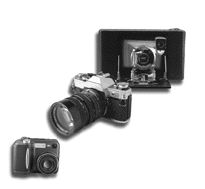
Often we receive new pieces of equipment with little information on how we can integrate them into our daily routines. These items are viewed as “technological toys”, and much of their potential goes …
Often we receive new pieces of equipment with little information on how we can integrate them into our daily routines. These items are viewed as “technological toys”, and much of their potential goes unused. Working in pulp mills and the servicing of them are very technical and intensive tasks — some of these new items can significantly improve and/or simplify many of these tasks.
One of the least expensive and most common of these items is the digital camera. I will not discuss the relative merits of the different models and their features, as that has been discussed previously both in this column and elsewhere. Instead, let’s consider applicable uses of a digital camera.
After the purchase of the camera itself, the photos are essentially free. In addition, their storage takes no (physical) room; sorting is a simple computer function (as they are just another computer file, they are automatically date-stamped) and they are instantly available for review, distribution or inclusion in documents. Previously, I used a film camera to record events in important projects – a practice which saved both time and trouble at later dates. However, I used to begrudge taking them, as each roll taken also required developing, sorting, labeling and filing. This made me reluctant to take photos and caused me to miss events that later became important. Now, I carry the camera in my pocket (my current digital is quite old, but still much smaller than many film cameras). I happily snap away anything that catches my eye, taking as many shots or angles as I desire – as with most digitals, my camera displays the photo taken for a few seconds, so I can determine if the shot was all I needed or if I need more. Another advantage is that a digital camera can often store several hundred photos.
Transferring photos from the camera to the computer is very simple. Some cameras use removable media (small electronic cards that you just plug into your computer); a common and convenient trend is the “cradle” – just set the camera in the cradle and the photos are instantly available as if on a hard drive on your computer. I keep a special folder on my computer to hold the photos. They are filed by mill, with subfolders for year and special projects. I can find a desired photo in seconds and I almost always have any photo I need as I can take so many with no cost in time or money.
Now that I have all these photos, what do I do with them all? First, there is no substitute for a photo. They illustrate my technical reports for customers, my papers for conferences and my presentations. When I need work done on a piece of equipment or at a location, I send a photo to the responsible party. I can mark the photo up electronically and just e-mail it to the person. The instantaneous nature of the electronic format means no waiting for developing, no squinting to see a tiny portion of a conventional photo and immediate transmittal via e-mail.
I once needed a part for an old and unusual pump. I could find no markings for model number and describing the part was impossible. I e-mailed a photo and phoned the service tech at the other end. He recognized the pump and the required part immediately from the photo (he had the grace not to comment on my poor description). I had the part the next morning. This is a typical example of using imagery to save time and effort. I frequently use photos for illustration of points in e-mails – how badly is that pump leaking? Just look at this photo! How did we set up that equipment last time? Let me check the photos we took – I will send you a copy! Nothing makes as great an impact or carries as much information as a photo.
What if you need a conventional photo? Just print it off! Photoquality inkjet printers are commonly available, as is photograde paper. You can take a photo and have a print in minutes – no sending film for developing and printing. Previously, turnaround on my mill photos was at least a couple of days – if I was in a hurry! If there was no rush, it might take weeks. Now I can have a print in minutes after I take the photo. But what about the quality of the digital photos – aren’t they grainy and blurry? This used to be true for some of the older cameras, but not anymore! Even cheap digital cameras can match the quality of a normal film camera up to the 5×7 print size. A good quality digital can match a film camera up to the 8×10 print size.
I routinely take photos of everything related to projects: how did we fit that crane in there; what exactly is under that cladding; how did we arrange the truck, tanks and pumps the last time we had to do this. Much of what we do is often repeated at a later date, either by another or ourselves. Having a photo record allows us to review how we did it last time and either repeat our successes or avoid our previous errors. So the next time you need to find an unusual part, direct someone to a particular piece of equipment or illustrate a point, use a photo!
Dan Davies is the application manager at Degussa Canada in bleaching & water chemicals. He can be reached at dan.davies@degussa.com
Print this page
